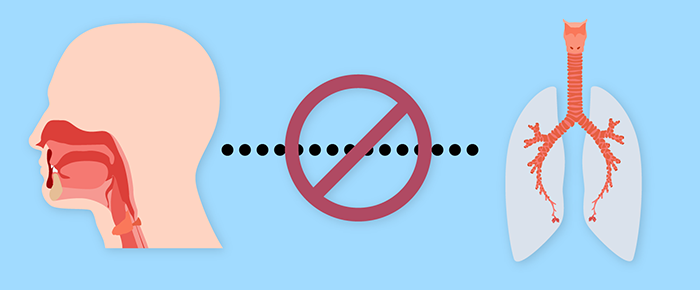Why You Should Consider Pulmonary Function and Defenses in Dysphagia Assessment

A key goal of a swallowing assessment is to estimate one’s risk for developing secondary complications from dysphagia, such as aspiration pneumonia or other aspiration related pulmonary sequelae. This is not as straightforward as was once believed.
Swallowing assessment includes examination of the biomechanical function of the swallowing mechanism. Clinicians are fortunate to have a number of valuable tools at their disposal – including videofluoroscopic swallow study (VFSS) and fiberoptic endoscopic evaluation of swallowing (FEES) – to examine the swallowing mechanism and definitively determine the presence of aspiration and pharyngeal phase pathophysiology. But, is this enough information to guide our recommendations and intervention plans?
What factors predict long-term outcomes?
A number of studies have shown that identification of aspiration and pharyngeal phase impairments of swallowing alone does not necessarily predict long-term outcomes, such as the development of aspiration pneumonia.1-4 For instance, in the 1998 Langmore et al. study, dysphagia alone was not an independent predictor of ones risk for development of aspiration pneumonia.2 Instead, the following were independent predictors:
- Dependency for feeding and/or oral care
- Number of decayed teeth
- Tube feeding
- Multiple (≥ 1) diagnoses
- Number of medications
- Smoking
In addition to dysphagia, a variety of other factors were associated with development of aspiration pneumonia,2 including pulmonary diagnoses such as:
- Chronic obstructive pulmonary disease (COPD)
- Gastrointestinal (GI) disease
- Poor secretion management
- Dental disease
- Poor oral care
- Tube feeding
Many of these independent predictors and other factors may be related to and/or co-occur with one or more impairments in pulmonary defenses.
What are Pulmonary Defenses?
Pulmonary defenses are a set a normal bodily mechanisms which guard the lungs from infections, such as pneumonia.5 Pulmonary defenses include:
- Protective anatomic features
- For example: The narrow twisting passages of the nose and the nasopharyngeal angle promote impaction of air pollutant particles; laryngeal closure.
- Mucociliary clearance (AKA, “Mucociliary escalator”)
- Mucus is propelled upward by cilia in the bronchi and bronchioles. Particles and aspirants become trapped in the mucus and the cilia beat in a highly coordinated rhythmic fashion to bring the mucus up to the hypopharynx, where it is then swallowed or expectorated.
- Airway reflexes
- For example: Cough aids clearance of mucus, particulates, aspirates, and other foreign materials from the lungs and large airways.
- Alveolar defenses
- For example: Alveolar macrophages are active phagocytes which can ingest inorganic mineral particulates and bacteria. Alveolar macrophages defend the alveolar surface.
Why should the swallowing specialist care about pulmonary function measures?
Pulmonary function measures reflect certain aspects of pulmonary defenses, including cough effectiveness, lung function, airway patency, and airway protection.
What are some important pulmonary function measures to be aware of?
- Spirometry – airflow & lung volumes: these measures provide an indication of obstructive versus restrictive respiratory disease. Several include:
- Forced vital capacity (FVC)
- Forced expiratory volume in 1 second (FEV1)
- FEV1/FVC Ratio
- Maximal inspiratory & expiratory pressures (MIP & MEP): these measures provide an indication of respiratory muscle strength.
- Gas exchange: Physicians can use gas exchange findings to help to determine underlying causes of hypoxemia. For example, arterial blood gas (ABG) includes measures of pH (hydrogen ions in the blood), partial pressure of carbon dioxide (PaCO2), partial pressure of oxygen (PaO2) and bicarbonate (HCO3).
- Other quick assessments of pulmonary function
- O2 saturation measures indicate how much oxygen is bound to hemoglobin in red blood cells – expressed as a percentage of the maximum.
- Respiratory rate refers to how many breaths are taken per minute.
Note: All of these measures must be interpreted in the context of other physical findings.
Summary
Consideration of pulmonary function and pulmonary defenses are important components of the clinical swallowing evaluation. Due to the multi-factorial complexity in individual risk for pneumonia, it is challenging for speech pathology clinicians to accurately estimate risk for development of aspiration pneumonia. A solid understanding of pulmonary function measures in the context of overall pulmonary defenses can aid clinical decision-making in the context of dysphagia assessment.
- Addington, W. R., Stephens, R. E., Gilliland, K., & Rodriguez, M. (1999). Assessing the laryngeal cough reflex and the risk of developing pneumonia after stroke. Archives of Physical Medicine and Rehabilitation, 80(2), 150-154. doi:S0003-9993(99)90112-0 [pii]
- Langmore, S. E., Terpenning, M. S., Schork, A., Yinmiao, C., Murray, J. T., Lopatin, D., et al. (1998). Predictors of aspiration pneumonia: How important is dysphagia? Dysphagia, 13, 69-81.
- Smithard, D. G., O'Neill, P. A., Parks, C., & Morris, J. (1996). Complications and outcome after acute stroke. Does dysphagia matter? Stroke, 27(7), 1200-1204.
- Smithard, D. G., Smeeton, N. C., & Wolfe, C. D. (2007). Long-term outcome after stroke: does dysphagia matter? Age and Ageing, 36(1), 90-94. doi:10.1093/ageing/afl149
- Happel, K. I., Bagby, G. J., & Nelson, S. (2004). Host defense and bacterial pneumonia. Semin Respir Crit Care Med, 25(1), 43-52. doi:10.1055/s-2004-822304 [doi]

